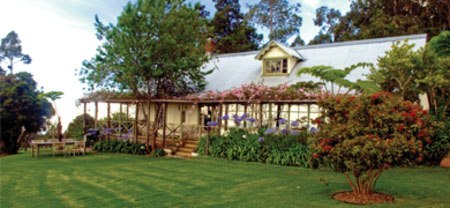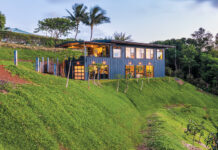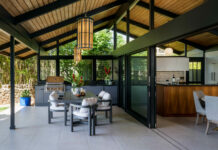Story by Rita Goldman | Photography by Tony Novak-Clifford | Jason Moore
October 8, 1907. This day we ascended from the lower country . . . to spend at least three weeks in the cool of the mountains. Ascending were Mr. & Mrs. F. C. Atherton, Harriet G. Forbes, Mr. & Mrs. W.O. Aiken, Martha Aiken, Higashi the cook . . . Katsu the maid . . . one wagon, six mules, seven horses, 1 cow, 1 calf and 1 cat. . . . The Athertons left regretfully after a week. The Borns left October 20, declaring that they had spent “the three happiest weeks of one’s life.”
—Idlewilde guest book, November 1906 to January 1912
 Before the 1930s, when a paved road made the summit of Haleakala accessible by automobile, the few hardy travelers who reached it did so on horseback, often camping overnight along the way. Mark Twain did, in 1866. Had he visited a mere decade later, Twain might have traded in his bedroll for a stay at Idlewilde, inscribing his name in its guest book, along with many a well-known Islander.
Before the 1930s, when a paved road made the summit of Haleakala accessible by automobile, the few hardy travelers who reached it did so on horseback, often camping overnight along the way. Mark Twain did, in 1866. Had he visited a mere decade later, Twain might have traded in his bedroll for a stay at Idlewilde, inscribing his name in its guest book, along with many a well-known Islander.
Built in the early 1870s, the little house not quite halfway up the mountain was a rustic retreat for the cream of island society. They would come up for a few days or a few weeks to hike in the rain forest; pick blackberries, walnuts, peaches and pears that grew in the surrounding gulches; and enjoy Olinda’s cool climate and the views of Maui’s northern coastline and the island of Lana‘i. It was so rustic, in fact, that, throughout its long history, the house was seldom used as a residence. But for nearly four years now, it’s been home to a couple who are descendants of the original owners.
“My great-great-uncle built Idlewilde,” says Edward. “It’s been in the family, on and off, for many years. People have always referred to it as ‘Idlewilde,’ but we haven’t been able to find out why.”
Around the turn of the last century, Worth Aiken bought the house. A businessman and community leader, Aiken used Idlewilde for nearly three decades as a way station for his horseback tours of the crater.
“At some point, Maui Land & Pineapple Company owned the house,” says Edward. “In the early 1970s, my uncle bought it.” Edward’s aunt and uncle had considered moving to the upscale neighborhood of Kula 200, but decided instead to rough it at Idlewilde. “My aunt used to tell me, ‘It’s lucky I was in my hippy phase, or the house wouldn’t have gotten back to the family.’”
Sally was a Colorado girl. She met Edward in college, and fell in love with him without knowing that she was about to marry into one of the largest and most influential families in Hawai‘i. Her first visit to Maui was on their honeymoon. It was 1980, and Edward’s grandmother was now Idlewilde’s owner.
“We came up for a picnic,” Sally recalls. “His grandmother offered to let us stay as caretakers. We lived here for about three years. Our son was born here.”
With a young family to raise, and a job offer from an international corporation that nothing on Maui could match, Edward and Sally reluctantly decided to leave. For the next two decades, they moved from one part of the country to another, wherever the company sent them.
“Ever since we left, we hoped there’d be some path back,” says Edward. “We never envisioned how it could happen, but we always hoped.”
In 2002, Fortune smiled on them. Rather, she positively beamed.
“We were empty-nesters, living in a 1,000-square-foot house we’d bought in Los Angeles two years before,” says Sally. “We learned that Edward’s dad was selling Idlewilde. We bought it—but I’d go to bed at night with a stomachache, wondering how we could afford both places.”
Then Edward’s company announced that it was selling its Hawai‘i division, and needed to transfer someone to the Islands to help with the transition. Edward leapt at the chance.
“A number of things fell into place at just the right time,” he says. Later, when the company wanted him to move back, Edward decided it was time to retire. He’s been working on the house and grounds ever since, referencing turn-of-the-century photographs to restore—in fact or in feeling—the way the property once was.
Over the years, various owners had added onto and refurbished the house, but often it had sat empty and neglected. By the time Sally and Edward moved in, Idlewilde was showing its age.
“My uncle had finished the upstairs in the seventies,” says Edward. “He went into the ceiling with a chainsaw, and 100 years of rat bones came down on him. A cousin did a lot of work on the inside—putting in some tongue-and-groove, and adding the stairs. Before that, there was only a ladder.
“A lot of what we initially put into the house was stuff you don’t see: new plumbing, electricity. And cleaning. There was a lot of Clorox involved for the first few weeks here.
“The foundation was the biggest thing. The kitchen and dining room were on the ground; the workmen had to crawl under the house to dig it out. They’d go under the house with garbage can lids to haul the dirt out with. It looked like the Great Escape.”
Edward and Sally replaced part of the roof, added a laundry room, put in a driveway that didn’t require four-wheel-drive. Because temperatures up here can drop into the forties, they fitted the living room’s inefficient fireplace with a wood-burning stove. Decades earlier, Edward’s uncle had enclosed the front porch to widen the dining room.
“He built the windows,” says Sally, “no two of them quite the same size.” To keep the look authentic when they built windows for the laundry room and home office, Edward and Sally ordered antique glass so old that it had gone wavery.
Much of the furniture they acquired over the years is also antique. A few pieces belonged to Edward’s family; others were purchased on the Mainland. And then there’s the dining room table.
“Years ago, we were staying with Edward’s uncle,” says Sally. “He was renovating his house, and we helped him paint. When he built an island in the kitchen, he put this table outside. I asked where it was, and he asked if we wanted it. Did we want it? That table went with us to L.A., then to Florida, then Chicago, then it stayed with a friend of ours in Colorado, and then it came here!
“We’re so glad we got to come back when we’re young enough to do what we want here,” she adds. “It’s about the place, but it’s also about where we are in our lives. We’ve lived in the big corporate homes; now we get to live more simply.”
More simply? With Idlewilde’s twenty-seven acres to inspire them, Edward and Sally are becoming organic gardeners. They started planting fruit trees on the slopes below the house: walnut, pear and peach trees that the old guest book had mentioned. They also purchased a pair of miniature cows: Anela and Hoku. “Anela was our first,” says Sally. “She was so small that she arrived here from the Big Island in a dog kennel.”
With Anela happily ensconced in the pasture, Sally mail-ordered two-dozen assorted chicks and told the Makawao Post Office to be on the lookout for the shipment. “They were born on a Saturday morning in Iowa, and were here by seven a.m. Monday,” she says. “I went down to get them, and they were in a shoebox. I was afraid to open it, thinking they couldn’t all have survived, but when I lifted the lid, there were twenty-five little mouths, peeping up hungrily at me.” Nowadays, Sally supplies friends with organic eggs—white, brown and green.
Gorse, an invasive weed, is a real problem up here, especially if you’re trying to establish yourself as an organic farm and don’t want to resort to pesticides. When Sally and Edward heard that goats will eat gorse, they purchased half-a-dozen dwarf goats.
“Then we worried about dogs getting in and killing them,” says Sally. “We heard that donkeys will protect goats. A woman on Pi‘iholo Road had a Miniature donkey that had saved her goats from being attacked. We bought the donkey, Pua, and for about a day, until she got to know us, if we tried to go into the pasture where the goats are, she wouldn’t let us near them. Peaberry arrived a month later. She’s a Miniature donkey who was living on a coffee farm; young coffee beans are called peaberries.”
Why the big fixation on miniatures? “I just figured that if we were going to have animals, we might as well have cute ones,” says Sally. “Besides,” Edward laughs, “Sally’s only five-three.”
Add to the critters and orchard an organic vegetable garden, and blackberry bushes on the hillsides above them, and you believe Sally when she says, “If the road closed tomorrow, we could live up here for weeks.”
Contentedly, too.
“Edward has always been interested in gardening, but on the Mainland we never had the space or the time. Besides,” she adds, “we feel so blessed to live here. Everyone who lived here before has improved Idlewilde. We wanted that to continue.”
“We’ve had a lot of offers from people who’d like to buy the property, but there’s no amount of money we’d sell for,” says Edward. “I’ve been coming up here since I was a kid, and this was our first home together. We have a lot of nostalgia for this place.”
Seeing Idlewilde blossom in their care, you get the sense that if the house could talk, it would say the feeling is mutual.





